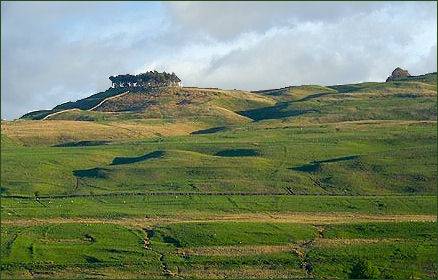Kirkcarrion
OS grid reference:-NY 939 238
 In a brooding and enigmatic position, around 2 miles to the south-west of Middleton-in -Teesdale, stands the windswept scenic Lunedale Ridge which is visible from across Lunedale and Teesdale.
In a brooding and enigmatic position, around 2 miles to the south-west of Middleton-in -Teesdale, stands the windswept scenic Lunedale Ridge which is visible from across Lunedale and Teesdale.
On top of the ridge is a tree-covered burial mound or round barrow, known as Kirkcarrion or Caryn's Castle. The name is said to derive from the burial of a local chieftain called Caryn, with the original name of the site being Carreg Caryn.
The prehistoric barrow, which is believed to date from the Bronze Age, stands at a height of 380 feet and is situated in the midst of a clump of pine trees at the top of a rock-strewn hill, is known locally as Caryn's Castle.
In 1804 a local farm labourer removed some stones from the mound and uncovered a cist burial or sepulcharal grave, four flat stones set up on edge formed the chamber, and it was covered by a fifth. The man who had found it, believing he had discovered buried treasure put his arms round it and shouted 'it's aa'll mine'. He took the stones away to build some walls on Crossthwaite Common. A funery urn with charried bones inside was discovered at the same time.
According to the Reverend William Bell, a former Vicar of Laithkirk, it seems that some great man, possibly a tribal chieftain known as Caryn had died either peacefully or as the result of a battle and his body had been burned on a funeral pyre. His ashes had been collected and placed in the urn and the 'kistvaen' created.
The artefacts from the cist burial eventually came into the possession of landowner, Lord Strathmore, who took them to Streatlam Castle, home of the Bowes family, near Barnard Castle, where the artefacts were placed on display, but have since been lost. An excavation was carried out in 1849 but records have not survived. Lord Strathmore's baliff, Mr C Raine, of Lonton, built walls around the burial mound and planted pine trees as a mark of respect for the ancient burial site. The trees were planted by Elija Foster and his son Alan Foster of Lowside Farm in 1936.
Access is by footpath from the B6276 Brough road.
Historic Buildings of Yorkshire
